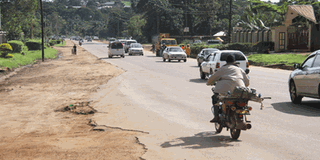Prime
Unveiling the myths of Entebbe’s Kitubulu stretch

Kitubulu slope near Ssese Gateway Beach where drivers have different myths about the cause of the road mishaps.Photos by Abubaker Lubowa and Rachel Mabala
What you need to know:
MYTH OR REALITY? You go to Entebbe at the weekend to catch a drink or two with friends. You sit by the lakeside and take in the cool breeze. However, do you know what myths lie on part of that highway on which you speed for fun? Gillian Nantume digs up the beliefs about Kitubulu black spot.
The 600-metre stretch from Ku Galaji (Kiyingi’s garage) to the Ssabaddu Gombolola headquarters on Entebbe highway is one of the deadliest spots. It is also the most beautiful.
The sheer magnificence of the scenery will strike a chord with a lover of nature. The road snakes its way between a large expanse of Lake Victoria on the left and what is left of Kitubulu Central Forest Reserve on the right.
On a hot afternoon, the vibrant atmosphere at the lake is infectious. Sometimes you have no choice but to stop and admire the carefree souls.
Naked children bathe in the lake – you will also find grown-up men bathing; swimmers take their chances, women wash clothes, lovers whisper, kanaabes (car washers) crisscross the road, drawing water, and idlers gaze forlornly at the horizon, pondering their next move.
However, beneath the serenity is a dark cloud of mystery. To superstitious residents, this stretch also happens to be the path of the vicious Nsamizi, a musambwa (spirit) in Ganda folklore, which uses it in the wee hours of the morning.

Part of the stretch where cars often overturn mostly at night
Speeding
On Monday June 18, 2012 at about 7am a call was made to at Entebbe Police Station. In Kitinda village, Abaita Ababiri, a mob had gathered to lynch a suspected robber. Six policemen got into patrol car UP 1295 and the driver, Moses Saloki, drove at breakneck speed. The thief’s life was at stake; he had to be saved. And he was; but barely.
After stowing him under the seats, the driver sped off. The destination was Entebbe Hospital, five minutes away. They never arrived.
Sam Kibirige, a bodaboda rider who witnessed the accident and helped remove the bodies from the wreckage, recalls that, “an Isuzu truck was parked on the right side of the road, opposite the entrance of Ssese Gateway Beach. The patrol car was speeding on the slope, but it was on the correct side. Suddenly, it veered off and hit the truck.”
The thief was counted among the dead. As with most accidents in Kitubulu, it was attributed to speeding.
Gerald Kasujja, LC1 Katabi-Kitubulu sub-ward, says almost every month, this stretch claims lives.
“The accidents occur in the early morning but we have never bothered to find out what causes them. It is impossible to do research on it.”
Alcohol
Like any other beach, the ones in Kitubulu also sell alcohol to revellers. They are also a haven for marijuana and other substance dealers and buyers. After partying the afternoon away, Kampala revellers stagger across the road, in the dark, to catch taxis to the city. Muhammad Agada, LC1 Kitubulu, blames inconsiderate drivers for the accidents.
“A bend on the road indicates that drivers should slow down, but for most, because it is a slope, they continue speeding, at the expense of pedestrians crossing.”
Agada, who has been LC1 since 1986, says he has petitioned the Resident District Commissioner (RDC)’s office time and again for a pedestrian footbridge across the road to no avail.
Superstition
Haruna Isabirye, a cab driver, believes there is a reason beyond speeding.
“Last week, a client called at midnight, requesting me to drive to the airport to pick up his children. I was in Kampala, just about to leave our offices.”
Because of the lateness, the client offered Isabirye Shs 150,000 for the trip. There were almost no cars on the road, and by 1.30am he was in Kitubulu.
“Near the washing bay, I saw a man dressed in black, crossing the road, I was driving at moderate speed. I flashed the headlights and hooted. Suddenly, the steering wheel locked and within a second, the car had turned and was facing the opposite direction.”
The headlights were on, the indicators were flashing, and the key was in the ignition but the car could not start.
“I saw the man disappearing into the thick vegetation behind the washing bay. I was sweating in spite of the cold. After a few minutes, the car started but I could not drive on to Entebbe. I called my client and asked him to get another driver.”
Isabirye believes that the encounter was an omen.
Agada admits that superstition exists among residents, although he is adamant in his belief that they are baseless.
“People say Nsamizi’s path begins where the Tampa Fish Processing Company is located. It is true that someone was building a hotel in the place but the building did not go beyond the walls. Of course, this should be attributed to lack of funds, not spirits.”
Wasswa Mukwaya, a former taxi driver, disagrees. Having driven on the road for more than 20years, Mukwaya insists that there is a malevolent force in the place.
“Three years ago, I had to drive some clients to Mbarara and we decided to leave Entebbe at 4am. At the Utoda stage in Kitubulu, I saw a woman dressed in white ahead standing by the roadside. I remember someone said it was strange that a woman should be out alone at that time.”
As they approached, the woman began crossing the road slowly.
“I fought with that car,” Mukwaya recalls. “My first thought was of saving the woman’s life. I thought she was drunk. But the brakes refused to work. The car was just speeding and the passengers were screaming. In desperation, I used the handbrake. The car overturned three times.”
No one was killed. On the other hand, none of them saw the woman again.
Presidential convoy not spared
Among residents, stories are rife about drivers seeing leopards crossing the road; or even babies crawling into oncoming cars. And there are those who still remember the accident involving the presidential convoy.
“In the early 90s, there used to be a market at Kitubulu stage,” says Muhamed Kawooya, vice LC1 chairman Kitubulu. “I was coming from work and I had just got off the taxi. I was walking through the market, greeting people, when I heard a loud bang.” People scattered and ran to take a look at the scene.
One of the escort cars in the presidential convoy had veered off the road into the market. None of the traders were hurt, but a presidential guard died on the spot.
“I remember people picking up the guns that had fallen off the pickup. The president came out of his car to inquire if any of the traders had been hurt. He asked them to forgive his drivers’ recklessness.”
Kawooya says accidents have claimed the lives of countless people in Kitubulu, but “as leaders, we cannot be seen to support the theory that there is a spirit here that demands a sacrifice every now and then.”

A wreckage of a vehicle after an accident on the bend at Kitubulu as you approach Entebbe Town
Police take
ASP Mable Asingwire, Oficer -in-charge of traffic, Entebbe Police Station puts the accidents down to the design and shape of the road.
“There is a bend and a slope on the road which tempt people to drive at a high speed. The markings in the middle of the road are also faint and people cannot see them. I am appealing to UNRA to do something about this.”
There is no lighting on that section of the road, and at night, the darkness caused by the thick vegetation makes it a disaster waiting to happen.
“Unlike in Kajjansi where there is a speed limit because of the high population, there are no speed limits in Kitubulu,” says Asingwire. “As police, we deploy traffic officers to control speeding and overtaking but they cannot be on the road at all times.”
Every weekend, the traffic officers, stationed opposite the Gombolola Headquarters, carry out breathalyser tests to determine the alcohol content in drivers and every day, impromptu checks on driving permits and mechanical conditions of the cars are also done.
“People should know that police cannot control accidents alone. We only enforce the law, but the driver is responsible for safeguarding his or her life.”
Other black spots
•Christ the King junction coming from Theatre LaBonita .
• Kalema Road-Stretcher junction- About 500 metres into Ntinda Stretcher road, there is another spot on Kalema Road-stretcher.
•Njeru near the bridge as you head to Jinja Town
Tracing Nsamizi's path
In the traditional beliefs of Buganda, the misambwa (spirits) dwell on hills, in rivers and in forests. Misambwa are in the lesser order of the complex spiritual world that ancient Baganda believed in. They were malevolent forces because there were rules as to who could go into its territory and when. Usually, people avoided them, or placed offerings in their path on appointed days. Nsamizi, according to traditionalists, is the resident spirit on Nsamizi Hill where State House sits. The path of this spirit is traced from Lake Victoria, through the Tampa Fish factory, Kitubulu, then Gombolola Headquarters up to State House.
On the other side of the hill, the path is traced down Kiwafu Central village, through Kiwafu Primary School, up to mu lusa (swamp before Entebbe International Airport).
Outside Kiwafu Primary School, there are rocks (ku lwaazi) that are located in the direct path of Nsamizi. Currently, it is a parking lot for sand trucks and pickups for hire. Tales abound among locals of gossiping women who sit at that spot in the early morning (between 2am – 3 am). It is not unknown for them to call upon anyone passing by to join them for a chat.




